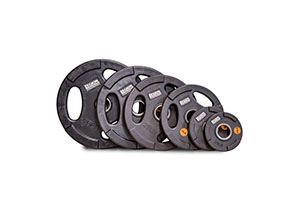 Rubber grip plates and rubber bumper plates are both types of weightlifting plates commonly used in fitness and strength training. While they share the characteristic of being made from rubber, there are a few key differences between the two:
Rubber grip plates and rubber bumper plates are both types of weightlifting plates commonly used in fitness and strength training. While they share the characteristic of being made from rubber, there are a few key differences between the two:
- Purpose: Rubber grip plates are primarily designed for traditional weightlifting exercises, such as bench presses, squats, and deadlifts. They are used in conjunction with a standard Olympic barbell and are often used in commercial gyms and fitness centers. On the other hand, rubber bumper plates are specifically designed for Olympic weightlifting and functional fitness exercises, which involve more dynamic movements like clean and jerks and snatches. Bumper plates are meant to be dropped from overhead positions without causing damage to the plates, barbell, or the lifting platform.
- Construction: Rubber grip plates typically have a solid cast iron or steel core with a rubber coating. The rubber coating provides protection for the plates and the floor, reduces noise, and offers some level of shock absorption. Rubber bumper plates, however, are constructed entirely from rubber, with a metal collar or insert in the center that allows them to be secured tightly to the barbell. The solid rubber construction of bumper plates provides a higher level of shock absorption, making them suitable for dropping from overhead positions.
- Weight Accuracy: Rubber grip plates are usually calibrated to within a specific weight tolerance, often around ±2%. This means that a 45-pound (20 kg) rubber grip plate will generally weigh very close to 45 pounds (20 kg). However, there can be slight variations in weight accuracy among different manufacturers. Rubber bumper plates, especially those used in competitive weightlifting, are typically more accurately calibrated. They are manufactured to stricter standards and undergo testing to ensure they meet the required weight specifications.
- Plate Thickness: Rubber grip plates tend to be thinner compared to bumper plates. This is because grip plates are designed to be loaded onto the barbell in larger quantities for exercises that require heavier weights. The thinner profile allows for more weight to be added to the bar without running out of space. Bumper plates are generally thicker, with a standardized diameter across different weight options. The consistent thickness allows the barbell to be at the correct height for lifting, regardless of the weight being used.
It’s worth noting that while rubber grip plates are not designed for dropping from overhead positions, they can still withstand some impact. However, repetitive dropping of rubber grip plates may cause damage to the plates or the floor over time.
Stop into any of Fitness 4 Home Superstore’s three Phoenix-area locations, and check out our full selection of rubber grip plates and rubber bumper plates today!

